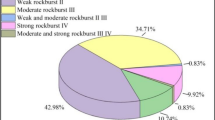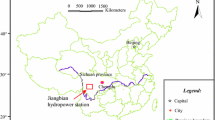Abstract
A rock burst often occurs during the construction period of deep-buried underground caverns. How to predict and prevent it is an urgent problem in underground engineering, especially in large hydropower stations. Combining grey correlation method, principal component analysis (PCA) and cloud theory, a novel analysis method that is proposed to evaluate rock burst. First, seven indices, namely, Rc, Rc/σ1, Rc/σt, σθ/Rc, Wet, H and KV, are selected. Considering the relationship between these indices, the grey correlation method is used to analyze these indices and reduce them. According to the correlation coefficients, the five indices, namely, Rc/σ1, Rc/σt, σθ/Rc, Wet and KV, consist of the final evaluated system. Second, the weight of each index is calculated using principal component analysis (PCA). Take into consideration of the ambiguity and randomness of rock burst; the multi-dimensional cloud model is used to evaluate the rock burst level. The proposed model is applied to a case study of the Jiangbian hydropower station to certify the feasibility and effectiveness of the novel method. The results are basically consistent with the actual rock burst level. At last, the selection of the evaluation system and the accuracy of the multi-dimensional cloud model are discussed. This novel method provides a new idea for the risk assessment of rock burst in deep-buried underground caverns.



Similar content being viewed by others
References
Adoko AC, Gokceoglu C, Wu L, Zuo QJ (2013) Knowledge-based and data-driven fuzzy modeling for rockburst prediction. Int J Rock Mech Min Sci 61:86–95. https://doi.org/10.1016/j.ijrmms.2013.02.010
Brady BT, Leighton FW (1977) Seismicity anomaly prior to a moderate rock burst - case-study. Int J Rock Mech Min Sci 14:127–132. https://doi.org/10.1016/0148-9062(77)90003-1
Cai MF, Ji D, Guo QF (2013) Study of rockburst prediction based on in-situ stress measurement and theory of energy accumulation caused by mining disturbance. Chin J Rock Mech Eng 32:1973–1980
Cook NGW, Hoek E, Pretorius JPG, Ortlepp WD, Salamon MDG (1966) Rock mechanics applied to the study of rockbursts. J South Afr Inst Min Metall 66:435–528
Diederichs M, Vazaios I (2018) Pre-construction prediction of strain-burst potential in blind tunnelling. In: ISRM international symposium-10th Asian rock mechanics symposium. International Society for Rock Mechanics and Rock Engineering,
Diederichs MS, Kaiser PK, Eberhardt E (2004) Damage initiation and propagation in hard rock during tunnelling and the influence of near-face stress rotation. Int J Rock Mech Min Sci 41:785–812. https://doi.org/10.1016/j.ijrmms.2004.02.003
Dong ZG, Wu JM, Liu CJ (2002) Summary of computing methods of rockburst prediction of underground caverns. J Geol Hazards Environ Preserv 02:6–9 +16
Dong LJ, Li XB, Peng K (2013) Prediction of rockburst classification using Random Forest. Trans Nonferrous Metals Soc 23:472–477. https://doi.org/10.1016/S1003-6326(13)62487-5
Dong LJ, Shu WW, Li XB, Zhang JM (2018a) Quantitative evaluation and case studies of cleaner mining with multiple indexes considering uncertainty factors for phosphorus mines. J Clean Prod 183:319–334
Dong LJ, Sun DY, Li XB, Ma J, Zhang LY, Tong XJ (2018b) Interval non-probabilistic reliability of surrounding jointed rockmass considering microseismic loads in mining tunnels. Tunn Undergr Space Technol 81:326–335
Dou LM, Lu CP, Mu ZL, Gao MS (2009) Prevention and forecasting of rock burst hazards in coal mines. Min Sci Technol (China) 19:585–591. https://doi.org/10.1016/S1674-5264(09)60109-5
Dowding CH, Andersson CA (1986) Potential for rock bursting and slabbing in deep caverns. Eng Geol 22:265–279. https://doi.org/10.1016/0013-7952(86)90028-1
Du K, Tao M, Li XB, Zhou J (2016) Experimental study of slabbing and rockburst induced by true-triaxial unloading and local dynamic disturbance rock. Mech Rock Eng 49:3437–3453. https://doi.org/10.1007/s00603-016-0990-4
Guo J, Zhang WX, Zhao Y (2018) A multidimensional cloud model for rockburst prediction. Chin J Rock Mech Eng 37:1199–1206
He MC, Miao JL, Feng JL (2010) Rock burst process of limestone and its acoustic emission characteristics under true-triaxial unloading conditions. Int J Rock Mech Min Sci 47:286–298
Jia YP, Lv Q, Shang YQ, Du LL, Zhi MM (2014) Rockburst prediction based on rough set and ideal point method. J Zhejiang Univ 48:498–503
Jiang QA, Feng XT, Xiang TB, Su GS (2010) Rockburst characteristics and numerical simulation based on a new energy index: a case study of a tunnel at 2,500 m depth. B Eng Geol Environ 69:381–388. https://doi.org/10.1007/s10064-010-0275-1
Li DY, Meng HJ, Shi XM (1995) Membership clouds and membership cloud generators. J Comput Res Dev 06:15–20
Li DY, Cheung D, Shi XM, Ng V (1998) Uncertainty reasoning based on cloud models in controllers. Comput Math Appl 35:99–123. https://doi.org/10.1016/S0898-1221(97)00282-4
Li YX, Yang JG, Gelvis T, Li YY (2008) Optimization of measuring points for machine tool thermal error based on grey system theory. Int J Adv Manuf Technol 35:745–750. https://doi.org/10.1007/s00170-006-0751-8
Li ZQ, Xue YG, Li SC, Qiu DH, Su M, Zhao Y, Zhou BH (2019) An analytical model for surrounding rock classification during underground water-sealed caverns construction: a case study from eastern China. Environ Earth Sci 78:602
Lin Y, Liu SF (2004) A historical introduction to grey systems theory. In: 2004 IEEE International Conference on Systems, Man and Cybernetics (IEEE Cat. No. 04CH37583), IEEE, pp 2403–2408
Liu ZB, Shao JF, Xu WY, Meng YD (2013) Prediction of rock burst classification using the technique of cloud models with attribution weight. Nat Hazards 68:549–568. https://doi.org/10.1007/s11069-013-0635-9
Ma J, Dong LJ, Zhao GY, Li XB (2019a) Focal mechanism of mining-induced seismicity in fault zones: a case study of yongshaba mine in China. Rock Mech Rock Eng 52:3341–3352
Ma J, Dong LJ, Zhao GY, Li XB (2019b) Ground motions induced by mining seismic events with different focal mechanisms. Int J Rock Mech Min Sci 116:99–110
Ma J, Dong LJ, Zhao GY, Li XB (2019c) Qualitative method and case study for ground vibration of tunnels induced by fault-slip in underground mine. Rock Mech Rock Eng 52:1887–1901
Ortlepp WD, Stacey TR (1994) Rockburst mechanisms in tunnels and shafts. Tunn Undergr Space Technol 9:59–65
Qian QH, Zhou XP (2018) Failure behaviors and rock deformation during excavation of underground cavern group for Jinping I hydropower station rock. Mech Rock Eng 1–13
Qiu DH, Li SC, Zhang LW, Cui W, Su MX, Xie FD (2015) Rockburst prediction based on tunnel geological exploration and ground stress field inverse analysis. Rock Soil Mech 36:2034–2040
Shang YJ, Zhang JJ, Fu BJ (2013) Analyses of three parameters for strain mode rockburst and expression of rockburst potential. Chin J Rock Mech Eng 32:1520–1527
Trivedi HV, Singh JK (2005) Application of grey system theory in the development of a runoff prediction model. Biosyst Eng 92:521–526. https://doi.org/10.1016/j.biosystemseng.2005.09.005
Wang YH, Li WD, Li QG, Xu Y, Tan GH (1998) Method of fuzzy comprehensive evaluations for rockburst prediction. Chin J Rock Mech Eng 17:493–501
Wang L, Lu ZL, Gao Q (2012) A numerical study of rock burst development and strain energy release. Int J Min Sci Technol 22:675–680. https://doi.org/10.1016/j.ijmst.2012.08.014
Wang YC, Jing HW, Ji XW, Mou TA, Zhang CL (2014) Model for classification and prediction of rock burst intensity in a deep underground engineering with rough set and efficacy coefficient method. J Cent South Univ 45:1992–1997
Wang X, Ren LJ, Jiao FC, Liu WJ (2017) The ecological risk assessment and suggestions on heavy metals in river sediments of Jinan. Water Sci Technol 76:2177–2187
Weng L, Huang LQ, Taheri A, Li XB (2017) Rockburst characteristics and numerical simulation based on a strain energy density index: a case study of a roadway in Linglong gold mine, China. Tunn Undergr Space Technol 69:223–232. https://doi.org/10.1016/j.tust.2017.05.011
Wold S, Esbensen K, Geladi P (1987) Principal component analysis. Chemom Intell Lab Syst 2:37–52
Xie H, Pariseau WG (1993) Fractal character and mechanism of rock bursts. Int J Rock Mech Min 30:343–350. https://doi.org/10.1016/0148-9062(93)91718-X
Xue YG et al (2019) Prediction of rock burst in underground caverns based on rough set and extensible comprehensive evaluation. B Eng Geol Environ 78:417–429
Yu HC, Liu HN, Lu XS, Liu HD (2009) Prediction method of rock burst proneness based on rough set and genetic algorithm. J Coal Sci Eng (China) 15:367. https://doi.org/10.1007/s12404-009-0406-0
Zhang Y, Xiao PX, Chen LJ (2014) Method of layout design based on ratio of rock strength to in-situ stress for large underground caverns. Chin J Rock Mech Eng 33:2314–2331
Zhang CQ, Lu JJ, Chen J, Zhou H, Yang FJ (2017) Discussion on rock burst proneness indexes and their relation. Rock Soil Mech 38:1397–1404. https://doi.org/10.16285/j.rsm.2017.05.022
Zhao GY, Dai B, Dong LJ, Yang C (2015) Energy conversion of rocks in process of unloading confining pressure under different unloading paths. Trans Nonferrous Metals Soc 25:1626–1632
Zhou KP, Lin Y, Deng HW, Li JL, Liu CJ (2016) Prediction of rock burst classification using cloud model with entropy weight. Trans Nonferrous Metals Soc 26:1995–2002. https://doi.org/10.1016/S1003-6326(16)64313-3
Acknowledgements
The authors would like to express appreciation to the reviewers for their valuable comments and suggestions that helped improve the quality of our paper.
Funding
Much of the work presented in this paper was supported by the National Natural Science Foundation of China (grant numbers 41877239 and 51309144), the programme for Outstanding PhD candidate of Shandong University (grant number 201413170), the National Program on Key Basic Research Project (grant number 2013CB036002) and the Shandong Provincial Natural Science Foundation (grant numbers JQ201513, ZR2014EEM028).
Author information
Authors and Affiliations
Corresponding author
Additional information
Responsible Editor: Amjad Kallel
Rights and permissions
About this article
Cite this article
Li, Z., Xue, Y., Li, S. et al. Rock burst risk assessment in deep-buried underground caverns: a novel analysis method. Arab J Geosci 13, 388 (2020). https://doi.org/10.1007/s12517-020-05328-4
Received:
Accepted:
Published:
DOI: https://doi.org/10.1007/s12517-020-05328-4




